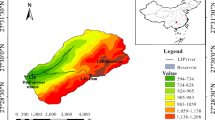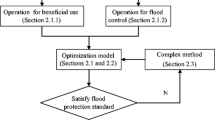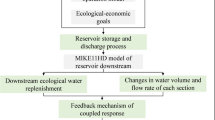Abstract
To make the formulation of the ecological release countermeasures of the reservoir adapt to the flood and dry water coming from the river and the ecological flow guarantee objectives of the Ministry of Water Resources, the ecological regulation release countermeasures model of the reservoir is studied. Taking Baishi Reservoir on the Daling River as an example, the ecological flow calculation results of Tennant method, Texas method and the ecological flow guarantee target (fixed value method) of the Ministry of Water Resources are selected for ecological dispatching to build an ecological dispatching model with optimal water supply, power generation and ecological coordination. There is no requirement to restore the flood limit water level at the end of the dispatching period. The average annual water supply shortage of the three methods are 8.20%, 20.21% and 11.62% less than the requirement to restore the flood limit water level. The average ecological water supply shortage are 16.39%, 14.40% and 10.96% less than the requirement to restore the flood limit water level. The average power generation of the fixed value method and the Texas method are 0.90% and 3.46% less than the requirement to restore the flood limit water level. The average power generation of the Tennant method is 3.73% more than the requirement to restore the flood limit water level. There is no requirement to restore the flood limit water level at the end of the dispatching period. The average annual water supply shortage of the reservoir by Tennant method are 19.91% and 10.69% lower than that by the constant value method and Texas method, the average non-flood season water shortage is 49.47% and 21.17% lower, the average annual power generation is 4.25% and 5.77% higher, and the average flood season power generation is 69.22% and 9.20% higher. At the end of the operation period, the reservoir water level does not need to restore the flood limit water level as much as possible, which can improve the utilization rate of the reservoir water resources. The operation mode of ecological water demand calculated by Tennant method can effectively combine the characteristics of incoming water to achieve the optimization of water supply, power generation and ecology.




Similar content being viewed by others
Explore related subjects
Discover the latest articles and news from researchers in related subjects, suggested using machine learning.Data Availability
All authors made sure that all data and materials support our published claims and comply with field standards.
References
Bajany DM, Zhang L, Xu Y et al (2021) Optimisation approach toward water management and energy security in Arid/Semiarid regions. Environ Process 8:1455–1480
Chen Y, Wang M, Zhang Y et al (2023) Cascade hydropower system operation considering ecological flow based on different multi-objective genetic algorithms. Water Resour Manage
Cuevas E, Cienfuegos M, Zaldivar D et al (2013) A swarm optimization algorithm inspired in the behavior of the social-spider. Expert Syst Appl 40(16):6374–6384
Dunbar MJ, Gustard A, Acreman MC (1998) Overseas approaches to setting river flow objectives. R and D Technical Report W6-161. Environmental Agency and NERC
Gu GY, Fang GH, Huang XF et al (2022) Research on reservoir operation based on the ecological flow process level. China Rural Water Hydropower 1:200–205
Hou TJ, Gao Y (2019) Analysis of ecological water demand in Zishui River Channel. J China Hydrol 39(5):40–44+60
Karaboga D (2005) An idea based on honey bee swarm for numerical optimization. Technical Report, Kayseri: Erciyes University
Kennedy J, Eberhart R (1995) Particle swarm optimization. In Proceedings of the 1995 IEEE international conference on neural networks, (4):1942–1948
Li Y, Lin J (2022) Calculation of minimum ecological flow in dewatering section of small hydropower stations: Taking Panxi cascade hydropower stations as an example. South-to-North Water Transfers Water Sci Technol 20(3):536–543
Li ZY, Liu DF, Huang Q et al (2017) Study on the ecological flux of the Ziwu River in Hanjiang River based on several hydrological methods. J N China Univ Water Resour Electr Power (Natural Science Edition) 38(1):8–12
Lin JQ, Li YK, Liu Y et al (2022) Recent progress in ecological operation and adaptive management for stimulating fish natural spawning. J Hydraul Eng 53(4):483–495
Liu CM, Men BH, Song JX (2007) Ecological hydraulic radius method for estimation of ecological water demand in river channel. Prog Nat Sci 1:42–48
Liu YY, Zhu JF, Zhao JS (2016) Development history and frontiers of river environmental flow research. J Hydroelectric Eng 35(12):23–34
Liu RR, Zhao Y, Liu YB (2022) Dispatching scheme based on ecological water supply. Shaanxi Water Resour 1:65–67
Ma MJ, Li Q, Zhou WR (2021) Study of carbon ecological compensation in Yellow River Basin based on carbon neutrality. Yellow River 7:1–7
Matthews RC, Bao Y (1991) The Texas method of preliminary instream flow determination. Rivers 2(4):295–310
Pastor AV, Ludwig F, Biemans H et al (2014) Accounting for environmental flow requirements in global water assessments. Hydrol Earth Syst Sci 18(12):5041–5059
Qian ZY (2001) Comprehensive Report on China's Strategy for Sustainable Development of Water Resources. Proceedings of the 2001 Annual Academic Conference of China Water Conservancy Society:11–26
Su H, Xu ZX, Li P et al (2022) Estimation of ecological baseflow with several hydrological methods at the Dahuangjiangkou reach of the Xijiang River. J Beijing Normal Univ (Natural Science) 58(2):269–276
Tennant DL (1976) Instream flow regimens for fish, wildlife, recreation and related environmental resources. Fisheries 1(4):6–10
Tharme RE (2003) A global perspective on environmental flow assessment: emerging trends in the development and application of environmental flow methodologies for river. River Res Appl 19(5):397–441
Tong X, Liu J, Peng T et al (2022) Research on ecological flow of middle Yalong River based on hydrological methods. Yangtze River 53(8):58–64+93
Wang WC, Lei GJ, Yin H et al (2015a) Optimal dispatch model of reservoir flood control based on SSO algorithm. Water Resour Power 33(4):48–51
Wang WC, Lei GJ, Qiu L et al (2015b) Optimal operation of hydropower stations using social spider optimization algorithm and its performance analysis. J Hydroelectric Eng 34(10):80–87
Wang HT, Jiao XY, Guo WX (2022) Study on ecological operation scheme of Qingshuihe River in Ningxia considering ecological water quantity. Water Resour Power 40(8):92–95
Wei YT, Pang Y, Luo J (2014) Calculation and analysis about ecological baseflow in main stream of Qinghe river. J Water Resour Water Eng 25(6):151–155
Xu ZX, Wu W, Yu SY (2016) Ecological baseflow: Progress and challenge. J Hydroelectric Eng 35(4):1–11
You JJ, Xue ZC, Lin PF et al (2022) Study on the two-layer structure ecological operation at the watershed scale II: Ecological operation application in the Songhua River Watershed. J Hydraul Eng 53(1):11–19
Yu JD, Zhang XY, Li J (2021) Calculation and analysis of ecological discharge in dehydration reach of long distance water diversion station. Water Conservancy Plann Des 12:160–163
Zhang XY, Yu JD, Zhang R et al (2022) Study on ecological discharge of the upper Bailong River based on various hydrological methods. Water Conservancy Plann Des 6:45–49
Zhao LL (2020) Analysis and study on ecological water use regulation under Baishi reservoir dam. Water Conservancy Tech Superv 6:161–164
Zheng ZH, Zhang ZZ, Huang Q et al (2010) Improvement and application on ecological water requirement Tennant method. J Sichuan Univ (Engineering Science Edition) 42(2):34–57
Funding
Key Scientific and Technological Problems in Henan Province (No:232102321140), Shandong Water Transfer Project Operation and Maintenance Center Cooperation Project (No: 37000000025002920210100 001), Simulation of Economic and Ecological Effects of National Water Network and Study on Its Sustainability (No: 2021YFC3200205), the Project of key science and technology of the Henan province (No: 202102310259), Henan province university scientific and technological innovation team (No: 18IRTSTHN009).
Author information
Authors and Affiliations
Contributions
Guanjun Lei: Conceptualization, Methodology, Writing-original draft. Junxian Yin: Investigation, Writing-original draft preparation. Wenchuan Wang: Formal analysis and data collection. Changshun Liu: Writing and editing-original draft. Hao Wang: Formal analysis.
Corresponding author
Ethics declarations
Ethical Approval
Not applicable.
Consent to Participate
All authors gave explicit consent to participate in this work.
Consent to Publish
All authors gave explicit consent to publish this manuscript.
Competing Interests
All authors gave explicit consent to publish this manuscript.
Additional information
Publisher's Note
Springer Nature remains neutral with regard to jurisdictional claims in published maps and institutional affiliations.
Rights and permissions
Springer Nature or its licensor (e.g. a society or other partner) holds exclusive rights to this article under a publishing agreement with the author(s) or other rightsholder(s); author self-archiving of the accepted manuscript version of this article is solely governed by the terms of such publishing agreement and applicable law.
About this article
Cite this article
Lei, G., Yin, J., Wang, W. et al. Study on Reservoir Operation Model Based on Ecological Flow Calculation. Water Resour Manage 37, 3543–3562 (2023). https://doi.org/10.1007/s11269-023-03513-0
Received:
Accepted:
Published:
Issue Date:
DOI: https://doi.org/10.1007/s11269-023-03513-0




